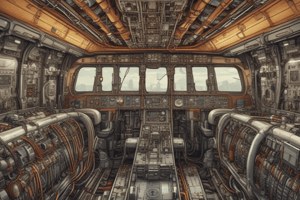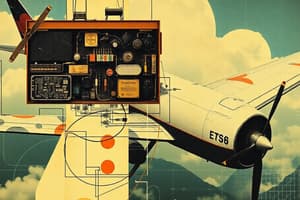Podcast
Questions and Answers
In an aircraft DC system, the function of the current limiter is to:
In an aircraft DC system, the function of the current limiter is to:
In an aircraft electrical system, the function of the distribution bus is to:
In an aircraft electrical system, the function of the distribution bus is to:
Which electrical bus powers vital or emergency loads?
Which electrical bus powers vital or emergency loads?
Which of the following is an advantage of alternating current compared to direct current?
Which of the following is an advantage of alternating current compared to direct current?
Signup and view all the answers
In an aircraft AC system, the inverter:
In an aircraft AC system, the inverter:
Signup and view all the answers
Altimeters, vertical speed indicators, airspeed indicators and artificial horizons belong to which instrument category?
Altimeters, vertical speed indicators, airspeed indicators and artificial horizons belong to which instrument category?
Signup and view all the answers
Voltmeters, ammeters and frequency meters belong to which miscellaneous instrument category?
Voltmeters, ammeters and frequency meters belong to which miscellaneous instrument category?
Signup and view all the answers
How would a typical quantitative circular scale display instrument indicate the maximum and/or minimum operating limits?
How would a typical quantitative circular scale display instrument indicate the maximum and/or minimum operating limits?
Signup and view all the answers
Absolute pressure is any pressure measured with reference to:
Absolute pressure is any pressure measured with reference to:
Signup and view all the answers
Fluid pressure is defined as:
Fluid pressure is defined as:
Signup and view all the answers
Static pressure is pressure:
Static pressure is pressure:
Signup and view all the answers
Which type of check is required when any item of the pitot/static system is removed or replaced?
Which type of check is required when any item of the pitot/static system is removed or replaced?
Signup and view all the answers
The air temperature that increases temperature due to the ram compression of the boundary layer is:
The air temperature that increases temperature due to the ram compression of the boundary layer is:
Signup and view all the answers
The temperature which is measured after the final turbine stage is:
The temperature which is measured after the final turbine stage is:
Signup and view all the answers
Thermocouple temperature measurement systems direct hot exhaust gases over the:
Thermocouple temperature measurement systems direct hot exhaust gases over the:
Signup and view all the answers
How is the fuel quantity measured in a mass indication system?
How is the fuel quantity measured in a mass indication system?
Signup and view all the answers
The purpose of an engine fuel system pressurising and dump valve is to:
The purpose of an engine fuel system pressurising and dump valve is to:
Signup and view all the answers
In the layout of a typical gas turbine engine fuel system, the fuel flow transmitter would be located:
In the layout of a typical gas turbine engine fuel system, the fuel flow transmitter would be located:
Signup and view all the answers
A fuel control unit senses inlet air pressure to:
A fuel control unit senses inlet air pressure to:
Signup and view all the answers
A supervisory electronic engine fuel control system is an electronic device that:
A supervisory electronic engine fuel control system is an electronic device that:
Signup and view all the answers
During engine start-up with a pressure control fuel control unit:
During engine start-up with a pressure control fuel control unit:
Signup and view all the answers
In the layout of a typical gas turbine engine fuel system, the high pressure shut-off cock would be located:
In the layout of a typical gas turbine engine fuel system, the high pressure shut-off cock would be located:
Signup and view all the answers
Why does a fuel control unit have a fuel density adjustment?
Why does a fuel control unit have a fuel density adjustment?
Signup and view all the answers
A hydro-pneumatic fuel control unit:
A hydro-pneumatic fuel control unit:
Signup and view all the answers
In the layout of a typical gas turbine engine fuel system, the fuel pressure differential switch would be located:
In the layout of a typical gas turbine engine fuel system, the fuel pressure differential switch would be located:
Signup and view all the answers
What is the difference between synthetic and mineral based engine oils?
What is the difference between synthetic and mineral based engine oils?
Signup and view all the answers
The SAE grading of oil gives a rating of the oil's:
The SAE grading of oil gives a rating of the oil's:
Signup and view all the answers
Synthetic engine lubricating oil vapours:
Synthetic engine lubricating oil vapours:
Signup and view all the answers
When replenishing a synthetic based oil system:
When replenishing a synthetic based oil system:
Signup and view all the answers
Synthetic engine oils are disposed of by an authorised contractor in accordance with:
Synthetic engine oils are disposed of by an authorised contractor in accordance with:
Signup and view all the answers
The characteristic of oil that ensures it remains bound together under compression loads is its:
The characteristic of oil that ensures it remains bound together under compression loads is its:
Signup and view all the answers
The main function of an electrically actuated oil tank shut-off valve is to:
The main function of an electrically actuated oil tank shut-off valve is to:
Signup and view all the answers
A significant feature of a total loss oil lubricating system is that it:
A significant feature of a total loss oil lubricating system is that it:
Signup and view all the answers
The main function of an engine lubrication system oil temperature transmitter is to:
The main function of an engine lubrication system oil temperature transmitter is to:
Signup and view all the answers
How is the oil cooled in a cold tank type dry sump lube system?
How is the oil cooled in a cold tank type dry sump lube system?
Signup and view all the answers
Study Notes
Electrical Systems
- The current limiter in an aircraft DC system limits the current to prevent electrical overload.
- The distribution bus in an aircraft electrical system distributes power to various components.
- The essential bus powers vital or emergency loads.
AC Systems
- An advantage of alternating current (AC) over direct current (DC) is that AC can be transformed to higher or lower voltages.
- The inverter in an aircraft AC system converts DC power to AC power.
Instrument Systems
- Altimeters, vertical speed indicators, airspeed indicators, and artificial horizons belong to the flight instrument category.
- Voltmeters, ammeters, and frequency meters belong to the electrical instrument category.
- Quantitative circular scale display instruments indicate maximum and/or minimum operating limits by displaying a marked range on the dial.
Pressure Measurements
- Absolute pressure is measured with reference to a perfect vacuum.
- Fluid pressure is defined as the force exerted per unit area.
- Static pressure is pressure measured in a static or still environment.
Pitot/Static Systems
- A leakage check is required when any item of the pitot/static system is removed or replaced.
Temperature Measurements
- The air temperature that increases due to the ram compression of the boundary layer is called ram air temperature.
- The temperature measured after the final turbine stage is called turbine outlet temperature.
- Thermocouple temperature measurement systems direct hot exhaust gases over the thermocouple.
Fuel Systems
- In a mass indication system, fuel quantity is measured by weighing the fuel.
- The purpose of an engine fuel system pressurising and dump valve is to pressurise the fuel system and dump excess fuel.
- The fuel flow transmitter is located in the fuel system to measure fuel flow.
- A fuel control unit senses inlet air pressure to regulate fuel flow.
- A supervisory electronic engine fuel control system is an electronic device that monitors and controls fuel flow.
- During engine start-up with a pressure control fuel control unit, the fuel flow is controlled by inlet air pressure.
- The high-pressure shut-off cock is located in the fuel system to shut off fuel supply.
- A fuel control unit has a fuel density adjustment to compensate for changes in fuel density.
- A hydro-pneumatic fuel control unit uses hydraulic pressure to regulate fuel flow.
- The fuel pressure differential switch is located in the fuel system to monitor fuel pressure differences.
Oil Systems
- The difference between synthetic and mineral-based engine oils is their chemical composition and performance.
- The SAE grading of oil gives a rating of the oil's viscosity.
- Synthetic engine lubricating oil vapors are less hazardous than mineral-based oils.
- When replenishing a synthetic-based oil system, the oil must be of the same type and grade.
- Synthetic engine oils are disposed of by an authorised contractor in accordance with environmental regulations.
- The characteristic of oil that ensures it remains bound together under compression loads is its cohesion.
- The main function of an electrically actuated oil tank shut-off valve is to shut off oil supply in emergency situations.
- A significant feature of a total loss oil lubricating system is that it does not recirculate the oil.
- The main function of an engine lubrication system oil temperature transmitter is to monitor oil temperature.
- In a cold tank type dry sump lube system, the oil is cooled by circulating it through a cooler.
Studying That Suits You
Use AI to generate personalized quizzes and flashcards to suit your learning preferences.
Description
Test your knowledge on the function of a current limiter in an aircraft DC system. Learn about the role of current limiters in ensuring safe operation and protecting electrical components.



